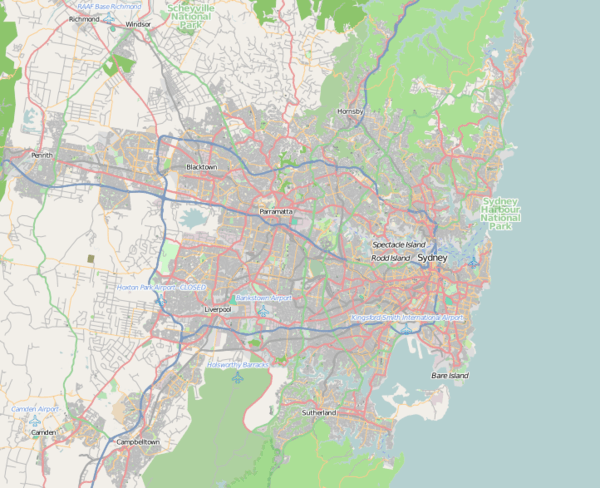Darlinghurst Courthouse
| Darlinghurst Courthouse | |
|---|---|
Darlinghurst_Courthouse.jpg) The courthouse, in 2014 | |
 Darlinghurst Courthouse Location in Greater Sydney | |
| General information | |
| Status | Complete |
| Type | Courthouse |
| Architectural style | Old Colonial Grecian |
| Location | Taylor Square, Oxford Street, Darlinghurst, New South Wales |
| Country | Australia |
| Coordinates | 33°52′49″S 151°13′04″E / 33.8803743182°S 151.2178697170°ECoordinates: 33°52′49″S 151°13′04″E / 33.8803743182°S 151.2178697170°E |
| Groundbreaking | 1826 |
| Construction started | 1835 |
| Completed | 1844; 1888 |
| Owner | Government of New South Wales |
| Landlord | Department of Justice |
| Technical details | |
| Material | Sandstone; slate; internal timber joinery; marble |
| Design and construction | |
| Architect |
|
| Architecture firm | Colonial Architect of New South Wales |
| Website | |
| Darlinghurst Court House | |
| Official name | Darlinghurst Courthouse |
| Type | Built |
| Criteria | a., b., c., d., e., f., g. |
| Designated | 2 April 1999 |
| Reference no. | 00792 |
| [1][2][3][4] | |
The Darlinghurst Courthouse is an heritage-listed courthouse building located adjacent to Taylor Square on Oxford Street in Darlinghurst, New South Wales in Australia. Constructed in the Old Colonial Grecian style based on original designs by Colonial Architect, Mortimer Lewis, the building structure was completed in 1880 under the supervision of Barnet's successor, James Barnet.
The courthouse is predominately used for sittings of the Supreme Court of New South Wales.
Heritage listing
On the 2 April 1999 the court house building was listed on the New South Wales State Heritage Register with the following statement of significance:[1][2][3]
Darlinghurst Courthouse and Residence is the finest Old Colonial Grecian public building complex surviving in Australia. Commenced in the 1830s, it has a long and continual association with the provision of law and order in Sydney, along with the neighbouring Darlinghurst Gaol complex. The building has variously contained District Courts, Supreme Courts and the High Court throughout its history and has been the site of many high-profile trials and inquiries, including sittings of the Royal Commission into Espionage in 1954 within the High Court wing. The Darlinghurst Courthouse and Residence is associated with Sir Richard Bourke, Governor of New South Wales from 1831-1837, who made a number of significant changes to the New South Wales justice system during his time as governor. Governor Bourke called for the construction of a new courthouse in Sydney to relieve pressure on the King Street Court and allow better transfer of prisoners between court and the proposed Darlinghurst gaol. Darlinghurst Courthouse and Residence is one of the few remaining examples of public buildings designed by Colonial Architect Mortimer Lewis. The many additions and alterations to the building over its history have been the responsibility of successive Government Architects and the Department of Public Works. The extension facing Victoria Street was designed by the Government Architect's Office and completed c. 1963.
— Statement of significance, New South Wales State Heritage Register.
See also
References
- 1 2 "Darlinghurst Court House and Residence". New South Wales State Heritage Register. Office of Environment and Heritage. Retrieved 22 November 2017.
- 1 2 "Darlinghurst Courthouse, Residence and Grounds". New South Wales State Heritage Register. Office of Environment and Heritage. Retrieved 22 November 2017.
- 1 2 "Darlinghurst Court House Group Including Interior, Fencing and Grounds". New South Wales State Heritage Register. Office of Environment and Heritage. Retrieved 22 November 2017.
- ↑ "Darlinghurst Courthouse (Place ID 1995)". Australian Heritage Database. Department of the Environment. 21 March 1978. Retrieved 22 November 2017.
Attribution
![]()
Further reading
- Apperly, Richard; Irving, Robert; Reynolds, Peter (1989). A Pictorial Guide to Identifying Australian Architecture: Styles and Terms from 1788 to the Present. Sydney, Angus & Robertson. ISBN 0-207-18562-X
- Faro, Clive (2000). Street Seen: A History of Oxford St. Carlton South, Melbourne University Press. ISBN 0-522-84967-9
- Jahn, Graham (1997). Sydney Architecture. Sydney, The Watermark Press. ISBN 0-949284-32-7
External links
| Wikimedia Commons has media related to Darlinghurst Court House. |